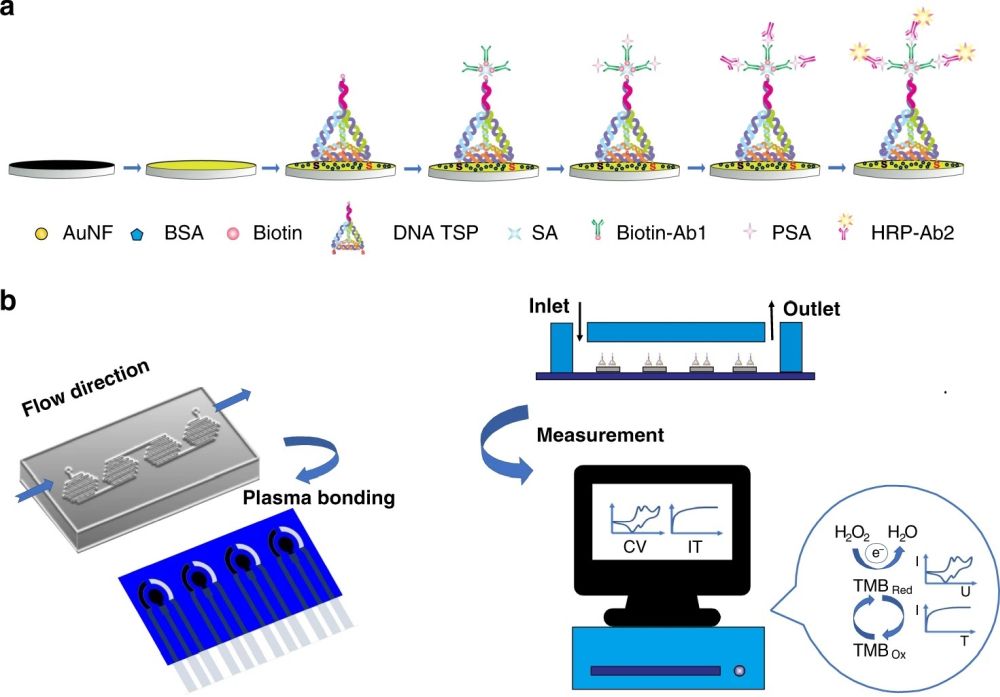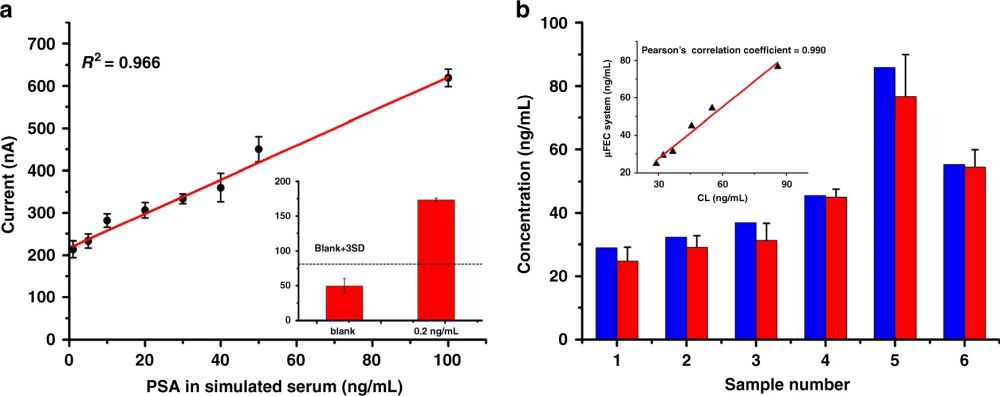
30 Apr Microfluidic electrochemical sensor combined with DNA tetrahedron-mediated immune-sandwich assay detects prostate cancer antigens
Prostate cancer being one of the major causing death in men has been the focus of attention for many researchers around the world. Early diagnostics of this type of cancer can significantly increase the chance of survival. Therefore, many efforts have been made to develop affordable, portable, and easy-to-use devices capable of such diagnostics. Among these efforts, microfluidics technology has been a major candidate for integrating diagnostic assays into portable and precise devices for point-of-care applications.
In a recent attempt in this regard, a research group employed DNA tetrahedron structural probes (TSPs) in a microfluidic device for the detection of prostate-specific antigen through microfluidic electrochemical sensing.
“In this work, we developed a novel microfluidic– electrochemical (μFEC) detection system by introducing electrochemical biosensors, DNA TSPs, and microfluidic chips simultaneously for simple, rapid, and sensitive PSA detection. The electrochemical biosensor we constructed was based on a screen-printed electrode modified with gold nanoflowers (Au NFs) with the purpose of increasing the specific surface area and improving the chemical signal response.”, the authors elaborated.

Reproduced under Creative Commons Attribution 4.0 International License. Feng et al., Microsyst., 2021.
The research team used screen-printed electrodes for sensing the changes in electrical signals caused due to the capturing of the antigens. In order to enhance the signal strength, gold nanoflowers were deposited on the surface of the electrodes which in turn increased the surface area. Next, the DNA TSPs were immobilized on the electrodes that provided a stable scaffold for the sandwich. Subsequently, biotin-anti-PSA (biotin-Ab1) and horseradish peroxidase-anti-PSA (HRPAb2) antibodies were attached to the DNA TSP scaffolds to complete the sandwich for capturing the prostate-specific antigens.
The sandwiched assembly was then integrated into PDMS microfluidic chips. The microfluidic chip consisted of meandering microchannels that were aligned to deliver the reagents to the electrodes. The HRP catalyzes the reduction of H2O2 that results in the generation of a signal that can be read using the electrodes via cyclic voltammetry and amperometry.
The microfluidic chip was first tested with spiked serum samples. It led to a linear range of 1-100 ng/mL and a limit of detection of 0.2 ng/mL in around 25 minutes. The proof of concept experiments were followed by patient sample experiments. The microfluidic device was shown to be capable of detecting PSA in clinical samples and presented a good correlation to the gold-standard chemiluminescence assays (CL).

Reproduced under Creative Commons Attribution 4.0 International License. Feng et al., Microsyst., 2021.
“As CL is the “gold-standard” assay in hospitals for PSA detection, it was well manifested that our μFEC detection system has complicated sample analysis capability and could be used in clinical sample analysis procedures. The total reaction time was less than 25 min, which means it is useful for POCT and has potential clinical applications for routine screening of prostate cancer.”, the authors concluded.
Read the original article: DNA tetrahedron-mediated immune-sandwich assay for rapid and sensitive detection of PSA through a microfluidic electrochemical detection system

Pouriya Bayat
Pouriya is a microfluidic production engineer at uFluidix. He received his B.Sc. and M.A.Sc. both in Mechanical Engineering from Isfahan University of Technology and York University, respectively. During his master's studies, he had the chance to learn the foundations of microfluidic technology at ACUTE Lab where he focused on designing microfluidic platforms for cell washing and isolation. Upon graduation, he joined uFluidix to even further enjoy designing, manufacturing, and experimenting with microfluidic chips. In his free time, you might find him reading a psychology/philosophy/fantasy book while refilling his coffee every half an hour. Is there a must-read book in your mind, do not hesitate to hit him up with your to-read list.


